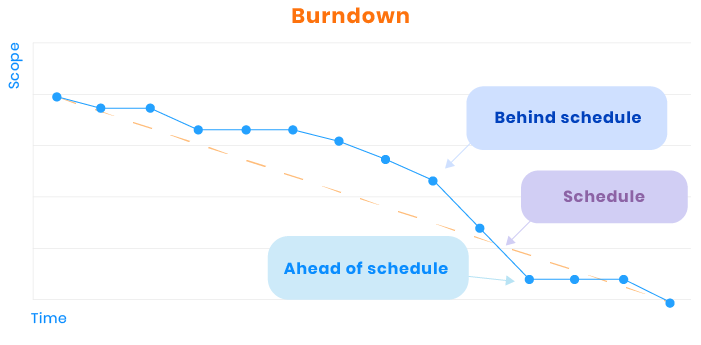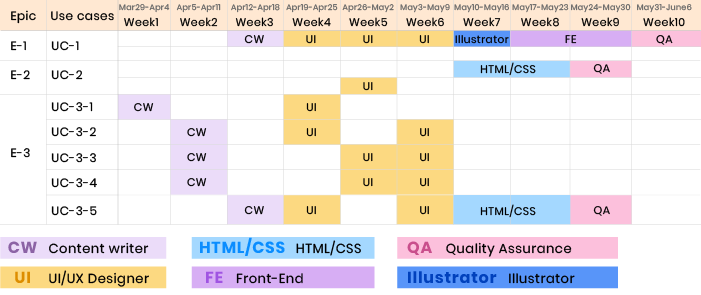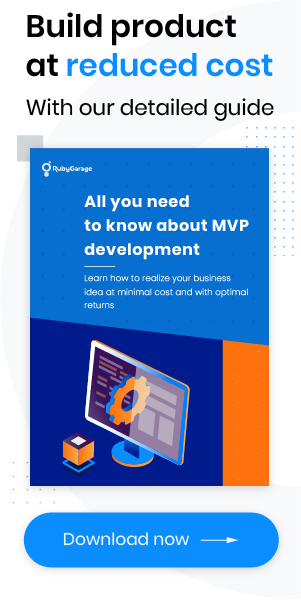-
Product Management
Software Testing
Technology Consulting
-
Multi-Vendor Marketplace
Online StoreCreate an online store with unique design and features at minimal cost using our MarketAge solutionCustom MarketplaceGet a unique, scalable, and cost-effective online marketplace with minimum time to marketTelemedicine SoftwareGet a cost-efficient, HIPAA-compliant telemedicine solution tailored to your facility's requirementsChat AppGet a customizable chat solution to connect users across multiple apps and platformsCustom Booking SystemImprove your business operations and expand to new markets with our appointment booking solutionVideo ConferencingAdjust our video conferencing solution for your business needsFor EnterpriseScale, automate, and improve business processes in your enterprise with our custom software solutionsFor StartupsTurn your startup ideas into viable, value-driven, and commercially successful software solutions -
-
- Case Studies
- Blog
Software Release Planning: Tips and Tricks by the RubyGarage Team
In Agile development, release planning is crucial. Without it, the delivery process is unpredictable. Proper planning is complicated and labor-intensive. That’s why businesses often simplify it, ignoring important but inconvenient stages and tools.
In the article below, we detail what software release planning is, why it’s so important at every stage of development, and how to build a quality release plan. Moreover, you’ll find valuable insights that will help you with planning your product releases. Finally, you’ll get the template we’re using for our own product management activities.
Software release planning meaning
According to Roman Pichler, there are splits over what software release planning means. Let’s define it in the simplest possible way.
Release planning is both setting up the desired schedule of several sequential software release dates and doing your best to meet this schedule.
Why software release planning matters
What is involved in release planning?
- Setting and clarifying objectives. This includes matching product objectives with the needs of both the business and the target audience.
- Defining the high-level scope. All team members should clearly understand the scope, at least at the highest level.
- Making rough estimates. Release planning is a time for the development team to evaluate the required workload.
- Controlling the scope of implementation. When we see the overall list of features and when each must be released, it’s convenient to oversee their completion.
- Identifying project triangle constraints. Your plan must take into account the time and budget aspects of the product development process.
A detailed guide to building a software release plan
Now it’s time to show you how we build release plans at RubyGarage. The guide below is based on our insights and experience. The planning process is divided into first-time release planning and updates during future iterations.
First release plan
- Define the product scope, or feature set. A feature set is a list of features that should be implemented. In Scrum, it should be in the form of a backlog.
- Estimate the feature set. This entails evaluating the work required to implement a feature. Estimation at this stage is done in Story Points for understanding the complexity of tasks.
- Specify the work-breakdown structure (WBS) for the scope. This means decomposing features into a hierarchy of tasks and subtasks.
- Define dependencies between flows. Some flows can be executed independently. Others are connected and can only be executed simultaneously. Generally, this step is about efficient workforce management.
- Form a team set that’s optimal for the product. You must understand the roles that will be involved in the development and the stage at which each will be involved.
- Set the planned velocity for both individuals and groups. Each team member must clearly understand how much work he or she should do during the first iteration. You must establish the same up for teams, too.
- Analyze risks. A risk analysis should contain a list of possible risks, the chances they’ll happen, and proposed steps for minimizing the consequences.
- Prioritize the product scope. You must analyze the backlog and set the priority for each separate feature. First of all, you should find those which must be included in the first release.
- Create a project schedule baseline and release plan. Based on results obtained from the previous steps, finalize your work by creating these two software release planning artifacts.
Updating the release plan during each iteration
- Analyze scope burndown. In terms of release planning, burndown is the scope of tasks remaining within the current release.
- Analyze changes in the backlog. Features and tasks added to the backlog or deleted from it must be carefully considered. If changes are significant, they can significantly affect the release plans.
- Analyze actual performance. Both personal and team velocity must be measured and compared with the planned numbers.
- Update product scope priorities. After each release, you must reprioritize the items in the backlog.
- Assess ongoing risks and factors that can affect your release plan or forecasts. Any new release changes the rules of the game. And you must always be aware of these changes.
- Update your release plan.

How and where to use a software release plan
As you can see, release planning is complicated and painstaking. Let’s explore the processes that can benefit the most from proper release planning.
Client and team expectation management
All the basics of client expectation management are more or less about communication. The basic rules are being honest and open from the start, providing assumptions, and following clear goals.
- Setting goals is one of the essential features of a release plan. Moreover, thorough planning is the best way to follow goals with the fewest possible fluctuations.
- Then backlog, one of the artifacts of the planning process, is a kind of storage for assumptions.
- The formalized planning system is a source of transparent communication with stakeholders.
Your employees need the same transparent relationships with other stakeholders as clients. Forming teams, planning, and analyzing velocity are key parts of release planning that affect team expectation management. Use these tools not for punishment but as a way to boost your team’s performance, as well as to make their work more comfortable.
Project budget management
Budget management starts with defining the budget and continues with executing, controlling, and updating it.
- The estimation within release planning is more about story points and complexity. However, it acts as a basis for you to make more detailed estimates and form a budget later.
- Releases are convenient milestones for controlling the budget. Based on a list of implemented features, it’s easy to identify any imbalance between the planned and factual spendings.
- Feature set changes must lead to changes in the budget.
Project scheduling control
The project schedule baseline is also known as the target schedule. It shows the project milestones, which you can compare with actual achievements.
This process is called schedule performance analysis. One of its measures is the Schedule Performance Index (SPI), showing whether a project is running ahead of or behind schedule.
These are the main scheduling control steps within Agile for each development iteration. Compare them with some of the release planning steps detailed above:
- Actualizing the current status of features
- Performing a retrospective review at the end of each iteration
- Making required changes to the backlog
- Evaluating iteration velocity
- Making required changes to the schedule
Do you see similarities between this list and the steps above? These processes are closely tied.
Our software release plan template

Software release planning: valuable advice
Below, you will find a list of insights you can use in your project planning process. All of them have been proven by multiple successful projects.
- Use a roadmap for planning several releases. A roadmap is aimed at planning several releases. It covers, among other things, the possibility of underperformance within a single iteration and includes a plan to make up for it in future iterations. For more information, see this video by Roman Pichler.
- Prioritize from the perspective of goals. Business needs and goals must be the cornerstone of any for-profit business. Set implementation priorities based on business goals.
- Make assumptions, document dependencies, and account for risks. Remember that assumptions are the safest way to offer changes to stakeholders. Dependencies are all the interesting facts related to your product which you could find but failed to classify. As for risks, we’ve already sketched out what risk analysis within the release planning process should look like.
- Estimate carefully. Estimation is often an underappreciated task due to the high risk of error. That’s why you should pay careful attention to the process and do your best.
- Deliver business value to end users as often as possible. This generally means releasing as often as possible.
- Release finished features only. Releasing unfinished features is a way to drop the overall project quality and accumulate technical debt.
- Use analytics. To achieve better results, analyze actual velocity, capacity (the maximum possible velocity within the current conditions), the number of bugs, and new features added. The tools we recommend for this are a burnup/burndown chart and a cumulative flow chart.
- Involve more people. Try to lead stakeholders and team members into the planning process.
- Set up an efficient deployment process. You should form standardized and detailed flows for developers and QA engineers, have automation tools for deployment, have a standardized and detailed flow for gathering and analyzing data, and have a contingency plan.
- Improve the release process continuously. Even if your current release process looks fine, it can have significant flaws or become flawed at any moment. That’s why continuous attention to planning is essential.
The release planning process is dangerous for startups that don’t have enough experience. And the risks may cost too much, even leading to the crash of the business.
Hiring an experienced agency is the best option. Prior to the start of the collaboration, you can ask your potential contractor about the processes they employ. A skilled team will provide you with a detailed plan of how to act.
Conclusion
Let’s recap our findings:
- Software release planning is integral if you go with Agile development.
- Release planning isn’t easy, but it’s always worth it.
- Planning gives you a better understanding of goals and allows you to control their achievement.
- As a result, the success rate of well-planned releases is fairly high, and releases should have fewer errors.
We hope the insights above will help you better plan your releases!
FAQ
-
Release planning is both setting up the desired schedule of several sequential software release dates and doing your best to meet this schedule.
-
- Setting and clarifying objectives
- Defining the high-level scope
- Making rough estimates
- Controlling the scope of implementation
- Identifying project triangle constraints
-
That's not to say it's easy. Every single step of release planning is rather risky. So it's better to rely on professionals.
Feel free to contact us and discuss your case!











